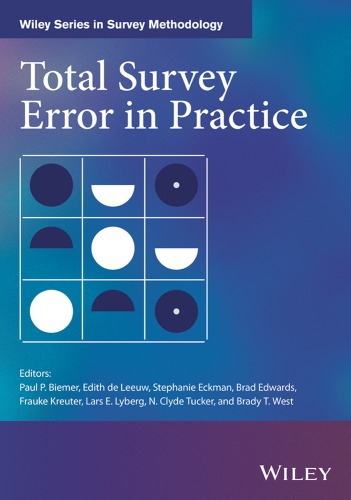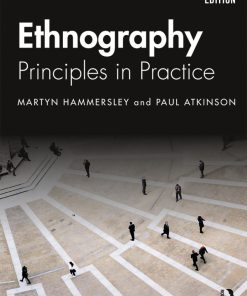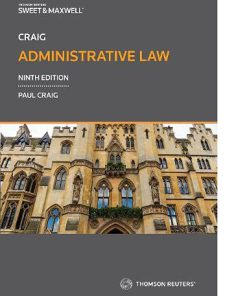Total Survey Error in Practice 1st Edition by Paul P Biemer 1119041694 9781119041696
$50.00 Original price was: $50.00.$25.00Current price is: $25.00.
Total Survey Error in Practice 1st Edition by Paul P. Biemer – Ebook Instant Download/Delivery ISBN(s): 1119041694, 9781119041696

Product details:
- ISBN 10: 1119041694
- ISBN 13: 9781119041696
- Author: Paul
This book provides an overview of the TSE framework and current TSE research as related to survey design, data collection, estimation, and analysis. It recognizes that survey data affects many public policy and business decisions and thus focuses on the framework for understanding and improving survey data quality. The book also addresses issues with data quality in official statistics and in social, opinion, and market research as these fields continue to evolve, leading to larger and messier data sets. This perspective challenges survey organizations to find ways to collect and process data more efficiently without sacrificing quality.
Table of contents:
Section 1: The Concept of TSE and the TSE Paradigm
1 The Roots and Evolution of the Total Survey Error Concept
1.1 Introduction and Historical Backdrop
1.2 Specific Error Sources and Their Control or Evaluation
1.3 Survey Models and Total Survey Design
1.4 The Advent of More Systematic Approaches Toward Survey Quality
1.5 What the Future Will Bring
References
2 Total Twitter Error
2.1 Introduction
2.2 Social Media: An Evolving Online Public Sphere
2.3 Components of Twitter Error
2.4 Studying Public Opinion on the Twittersphere and the Potential Error Sources of Twitter Data: Two Case Studies
2.5 Discussion
2.6 Conclusion
References
3 Big Data
3.1 Introduction
3.2 Definitions
3.3 The Analytic Challenge: From Database Marketing to Big Data and Data Science
3.4 Assessing Data Quality
3.5 Applications in Market, Opinion, and Social Research
3.6 The Ethics of Research Using Big Data
3.7 The Future of Surveys in a Data‐Rich Environment
References
4 The Role of Statistical Disclosure Limitation in Total Survey Error
4.1 Introduction
4.2 Primer on SDL
4.3 TSE‐Aware SDL
4.4 Edit‐Respecting SDL
4.5 SDL‐Aware TSE
4.6 Full Unification of Edit, Imputation, and SDL
4.7 “Big Data” Issues
4.8 Conclusion
Acknowledgments
References
Section 2: Implications for Survey Design
5 The Undercoverage–Nonresponse Tradeoff
5.1 Introduction
5.2 Examples of the Tradeoff
5.3 Simple Demonstration of the Tradeoff
5.4 Coverage and Response Propensities and Bias
5.5 Simulation Study of Rates and Bias
5.6 Costs
5.7 Lessons for Survey Practice
References
6 Mixing Modes
6.1 Introduction
6.2 The Effect of Offering a Choice of Modes
6.3 Getting People to Respond Online
6.4 Sequencing Different Modes of Data Collection
6.5 Separating the Effects of Mode on Selection and Reporting
6.6 Maximizing Comparability Versus Minimizing Error
6.7 Conclusions
References
7 Mobile Web Surveys
7.1 Introduction
7.2 Coverage
7.3 Nonresponse
7.4 Measurement Error
7.5 Links Between Different Error Sources
7.6 The Future of Mobile web Surveys
References
8 The Effects of a Mid‐Data Collection Change in Financial Incentives on Total Survey Error in the National Survey of Family Growth
8.1 Introduction
8.2 Literature Review: Incentives in Face‐to‐Face Surveys
8.3 Data and Methods
8.4 Results
8.5 Conclusion
References
9 A Total Survey Error Perspective on Surveys in Multinational, Multiregional, and Multicultural Contexts
9.1 Introduction
9.2 TSE in Multinational, Multiregional, and Multicultural Surveys
9.3 Challenges Related to Representation and Measurement Error Components in Comparative Surveys
9.4 QA and QC in 3MC Surveys
References
10 Smartphone Participation in Web Surveys
10.1 Introduction
10.2 Prevalence of Smartphone Participation in Web Surveys
10.3 Smartphone Participation Choices
10.4 Instrument Design Choices
10.5 Device and Design Treatment Choices
10.6 Conclusion
10.7 Future Challenges and Research Needs
Appendix 10.A: Data Sources
Appendix 10.B: Smartphone Prevalence in Web Surveys
Appendix 10.C: Screen Captures from Peterson et al. (2013) Experiment
Appendix 10.D: Survey Questions Used in the Analysis of the Peterson et al. (2013) Experiment
References
11 Survey Research and the Quality of Survey Data Among Ethnic Minorities
11.1 Introduction
11.2 On the Use of the Terms Ethnicity and Ethnic Minorities
11.3 On the Representation of Ethnic Minorities in Surveys
11.4 Measurement Issues
11.5 Comparability, Timeliness, and Cost Concerns
11.6 Conclusion
References
Section 3: Data Collection and Data Processing Applications
People also search:
what is total survey error
what is systematic error in surveying
total survey error framework
total survey error workshop
total survey
You may also like…
Education Studies & Teaching
Computers - Programming
Computers - Programming
Politics & Philosophy - Social Sciences
Ethnography Principles in Practice 4th Edition Martyn Hammersley Paul Atkinson
Politics & Philosophy - Anthropology
World Religions In Practice A Comparative Introduction 1st Edition Paul Gwynne
Jurisprudence & Law - Constitutional Law
Business & Economics
Engineering












